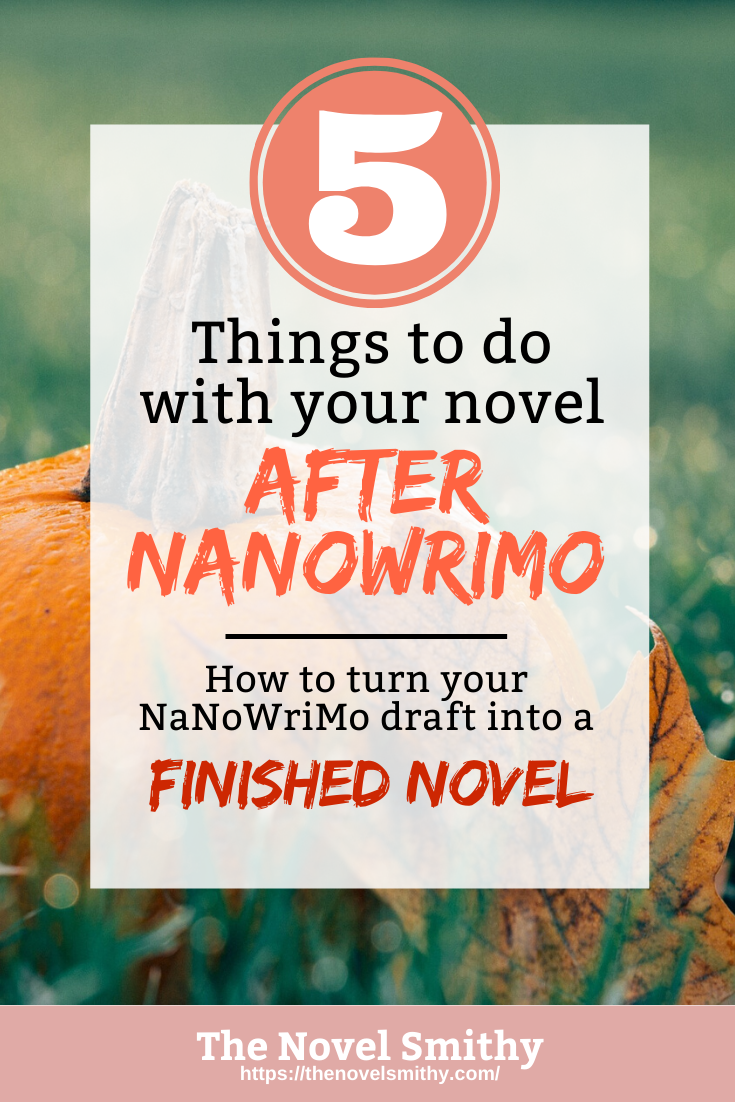5 Things to Do with Your Novel After NaNoWriMo Ends
December is almost here…
…and while that might mean candy canes and snow to some people, to writers it means National Novel Writing Month is officially over. It’s an amazing feeling to reach the other side of this writing challenge, and whether you’ve completed your first draft or only written a few scenes, I hope you’re proud of the story you started this month.
However, that’s the catch—NaNoWriMo is just the start. If you want to keep your momentum going, you’ll need a plan for what comes next, which raises the question: What should you do with your novel after NaNoWriMo?
What Comes After NaNoWriMo?
Contents
 In my experience, the week after NaNoWriMo always comes with some strange feelings.
In my experience, the week after NaNoWriMo always comes with some strange feelings.
On the one hand, you’re probably relieved that it’s finally over. NaNoWriMo is an intense process for most writers, and it’ll no doubt be a breath of fresh air to have free time in your day again. Couple that relief with the excitement of having a finished first draft—or even half of one—and you get a heady mix of emotions. Yet, once that high wears off, you may be struck by an intense feeling…
You don’t know what comes next.
Where do you go from here? How do you turn this (likely rough) first draft into something complete, polished, and ready to share with the world? What separates a first draft from a final one?
Unfortunately, your journey isn’t over when NaNoWriMo ends, but what comes next doesn’t have to be difficult. If you made it through NaNoWriMo with your sanity intact, everything that comes after NaNoWriMo will be just as manageable with a bit of motivation.
The key is having a plan for what needs to happen and when.
What to Do with Your Novel After NaNoWriMo
Finish Your Novel:
Even if you hit that coveted 50k, your novel may not be complete, and this is doubly true if you didn’t quite meet your NaNoWriMo goals. Don’t let this stress you out though—the first few weeks of December are a great time to buckle down and finish your first draft.
To make this process easier, there are a few things you’ll want to think about.
For starters, you’ll need to have a plan in mind, just like you (hopefully) did for November. Sit down with your calendar and look at your schedule for the next few weeks.
- Do you have any large chunks of free time?
- How can you fit writing into your existing schedule?
- Do you commute, take long lunch breaks, or get up early/stay up late?
- How could you dedicate some of this time to writing?
With an idea of how you’ll make time to write, next you’ll want to set clear goals for yourself. Calculate how many words you can realistically write each day and commit to reaching those numbers. Write these goals down so you can hold yourself accountable.
Of course, if you’re unsure how long your final novel should be, you’ll want to consider that before you dive back into writing. This will not only help you plan, but it’ll calm any anxiety you feel when your novel seems “longer/shorter than it should be.”
From there, all that’s left to do is sit down and write.
Once you’ve officially written “the end,” the real fun begins!

- How an Editorial Calendar Can Organize Your Writing Life
- Your Game Plan to Break Through Writer’s Block for Good
- 8 Ways to Create Positive Writing Habits (And 5 Habits to Try)
- How Long Should Your Novel Be?
Do Some Editing:
With a completed first draft in hand—whether you finished it during or after NaNoWriMo—you can move on to the next major stage of the writing process: editing.
However, you won’t want to just dive right in.
Instead, if you’re going to get the most out of self-editing, you’ll need to be purposeful in your approach. For starters, these early rounds of edits aren’t about polishing your prose or perfecting the details. Instead, they’re all about rooting out large gaps in your plot, inconsistencies in your characters, and other major errors.
After all, NaNoWriMo required you to write fast and loose—your first draft will probably need some cleaning up as a result, and that’s ok!
When you sit down to edit, here’s a rough plan to follow:
- Set your draft aside for at least two weeks to gain a fresh perspective
- Read through your entire draft, taking notes as you go
- Review those notes and develop a plan for what needs fixing
- Focus on big picture plot errors before moving on to characters
If you find yourself making major changes during this process, don’t worry. This is a very normal part of writing a novel, and is where you’ll get to hone in on your story’s final form. Plus, this helps you get your draft into a readable state before you move on to the next step on this list!
Get Feedback:
No matter how hard we try, it’s impossible to be truly objective about our own writing.
Think about it—you’ve been neck deep in your story for weeks now, living and breathing its plot, world, and characters. Is it really realistic to ask yourself to then tear that story to shreds?
Probably not…
On the other hand, an outsider would be much more apt to give you the constructive criticism you need, and will notice problems and areas to improve that you simply don’t see. This is vitally important for your novel, and will give you a fresh new perspective on your story.
Unfortunately, the hardest part of this step is usually finding the right people for the job. You need someone who will give you honest, well-informed, and constructive criticism, and not everyone has the knowledge or temperament to do so. A dear friend might go too easy on you, while a total stranger might be unnecessarily harsh.
While the right person will be different for everyone, here are a few places to start:
- A fellow writer who also completed NaNoWriMo
- Beta readers or critique partners from online writing forums
- A developmental editor
- A close writing friend you’ve worked with before
Once you find a person or two that you can trust with your story, you’ll want to set some guidelines and then hand your draft over. Give yourself some time to rest while you wait for their feedback and don’t stress too much. While criticism is never fun, once you get past the initial sting this may end up being the most valuable thing you do for your final novel.
Polish the Details:
After getting feedback from editors and readers, you’ll be ready to dive into a deeper round of self-editing. Here is where you’ll finally get into the nitty-gritty of your story, fixing any lingering plot and character-related issues before moving on to polishing your prose, dialog, descriptions, and more.
For some writers, this is their favorite part of the process, while others would do anything to skip it—where you fall on this spectrum really depends on your personality.
However, regardless of whether you relish or hate this methodical detail work, it’s what will ultimately give your novel a more professional feel. Take your time on this step, read your draft out loud (or get your computer to read it for you), and make at least two passes on each chapter of your novel.
Once you’re confident your novel is in its final form, you’ll want to look through it one last time to ensure you don’t have any missing punctuation, misspelt words, or funky grammar. This, like getting feedback, is another great time to bring on a professional—specifically, a professional proofreader. While you can certainly do this yourself, having a trained eye to spot errors will make the process go much more smoothly.
Publish Your Novel:
From here, you have many paths to take.
Some writers are content just having a finished novel to call their own, sharing it with friends and family and then setting it aside. Others have their hearts set on getting a publishing deal with a traditional publishing house, making this the perfect time to query literary agents. Still others choose to self-publish, opening up a whole new set of techniques to master.
Personally, I’m most experienced with self-publishing, and in my opinion this is by far the most accessible publishing option for most writers—even with all the new skills you’ll need to learn.
While you can 100% publish your novel using only Microsoft Word and MS Paint, I wouldn’t recommend it. Instead, there are a variety of DIY tools you can use to compile, format, design, and finally publish your brand new novel:
Compile: Scrivener
Format: Vellum
Design: Canva (or Photoshop)
Publish: KDP
Though this process may feel intimidating at first, it’s kind of amazing when you think about it—after all, if you’ve made it to this point in the writing process, you’ve just become a published author. What started as a NaNoWriMo draft has turned into a finished novel you can read, share, and hold in your hands, all because you kept your up momentum after NaNoWriMo!
If there’s a better way to motivate yourself as a writer, I don’t know what it is. 🙂
- How To Self-Publish An Ebook
- Self-Publishing Tips: How To Format An Ebook And Print Book With Vellum


Leave a Reply